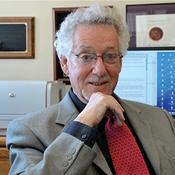
Sheldon Weinbaum has led a remarkably creative and multifaceted career marked by a broad range of innovations in biomechanics, aerodynamics, and mathematics. Just as importantly, he continues his pioneering and influential efforts to advocate for and support women and underrepresented groups in science and engineering careers.
The human body is a finely tuned and enormously sophisticated system and understanding the physics and mechanics of how it functions is essential to health. This is the realm of biomechanics, in which Sheldon Weinbaum has blazed new trails for decades as a biomedical engineer.
Growing up as a math prodigy who was interested in science from a young age, Weinbaum did not start out intending to work on subjects like blood flow, bioheat transfer, or transport aspects of arterial disease. After earning his undergraduate BAE degree from Rensselaer Polytechnic Institute in 1959 and his doctorate in engineering from Harvard in 1963, when both the Cold War and the Space Age were at their height, he worked for space and defense contractors on problems of high altitude aerodynamics. But in the 1960s and 1970s, Weinbaum found himself swept up into the societal struggles against prejudice and injustice, once protesting his employer’s discriminatory hiring practices and being fired as a result. He joined the faculty at City College of New York (CCNY) in 1967 and changed his focus to biomechanics, an interest he had developed during his earlier corporate career. At CCNY, he would now work to teach new generations of engineers and to improve human health, simultaneously pursuing his passions for engineering and for social justice.
As an engineer, Weinbaum is globally recognized as a leader in biomechanics. While many biomechanical engineers tend to specialize in one or two specific human anatomical systems, Weinbaum's contributions range across the numerous mechanical functions of the body, with creative new insights into cardiovascular disease, heat exchange between blood and the surrounding tissue, cholesterol (LDL) transport, bone fluid flow, capillary fluid exchange, and eye disease. His very first work in biomechanics, done in his spare time when he was still employed as an aerodynamicist, provided a seminal model for intraocular fluid pressure and its relation to the blinding disease of glaucoma. His aerodynamics work also informed his later studies in blood flow and lubrication theory. He found that the fluid dynamics of red cells skiing on the endothelial lining of your capillaries have a remarkable similarity to humans skiing on snow. He also demonstrated that it is possible to design a high-speed train whose weight was supported by a giant ski gliding on inexpensive fiber fill materials if the leakage of air at the edges of the ski could be eliminated.
With a combination of great scientific knowledge, intuitive insight, and creative imagination, Weinbaum's approach is to solve outstanding mysteries whose solutions have eluded other researchers. One example involves atherosclerosis, the silent but deadly buildup of plaque inside our arteries that underlies heart disease. Weinbaum showed how previously unknown mechanisms in the cells lining our arteries promote the development and growth of plaques that can lead to heart attack and stroke. His team also discovered how tiny particles of calcium in the thin fibrous caps of vulnerable lesions aggregate, which can lead to cap rupture and sudden death.
Focusing elsewhere in the body, he discovered and modeled the mechanisms by which bone cells can detect mechanical strains and induce bone-forming cells to adapt; contributed to the understanding of the flow and filtration of fluids through tissues and capillaries; provided vital work on the mechanical signals regulating kidney function; and developed a new theory of heat exchange between tissues and blood vessels with the Weinbaum-Jiji equation (one of several important equations that bear his name). Throughout his career, Weinbaum’s insights and models have changed or improved the conventional wisdom in many areas of biomechanical research, resulting in life-saving new treatments and procedures. His is truly a lifetime of innovation and reduction to successful practice.
Beyond his scientific contributions, Weinbaum’s career is also a story of advocacy on behalf of minorities and women in science and engineering—opportunities that have been a key factor in his decision to spend his entire academic career at CCNY. He set up the first CCNY summer outreach program for city high schools and worked tirelessly to recruit outstanding minority and women faculty members for the School of Engineering. He led initiatives to increase minority participation not only at CCNY but also across scientific disciplines, through efforts including the identification of diverse candidates for election to the National Academies of Science, Engineering, and Medicine (Weinbaum is one of few who are members of all three). He also led a class-action lawsuit against the State of New York for racially discriminatory practices in higher education funding.
For Sheldon Weinbaum, devising new equations to explain blood flow or working to ensure that marginalized students have the chance to reach their full potential as scientists and engineers all grow from the same motivating passion: to serve humanity while using science and technology to enhance and prolong life.

